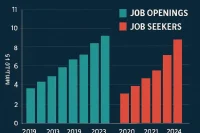As competition for top talent intensifies in 2025, companies are moving beyond traditional healthcare and 401(k) offerings to stand out. One emerging trend is subscription-style employee benefits—ongoing, flexible perks delivered via monthly memberships or credits rather than annual enrollment windows. From meal kits and streaming services to wellness apps and coworking access, subscription benefits empower employees to choose what matters most to them, boosting engagement, well-being, and retention.
This article explores why subscription benefits are taking off, the most popular models, implementation best practices, and how to measure their impact on your workforce.
Why Subscription Benefits Matter
1. Personalization at Scale
Traditional “one-size-fits-all” perks (gym discounts, commuter subsidies) often go underutilized. Subscription benefits give each employee a monthly stipend or curated package, enabling them to select services—yoga classes, meditation apps, meal deliveries—that fit their lifestyle and needs.
2. Continuous Engagement
Unlike annual open-enrollment periods, subscription offerings create regular touchpoints. Monthly emails with benefit balances, curated “featured partners,” and reminders to re-up stimulate awareness and foster a habit of self-care.
3. Cost Predictability
Employers pay a set per-employee, per-month fee, simplifying budgeting for total-rewards teams. With clear utilization data, organizations can fine-tune offerings to maximize ROI and eliminate underused subscriptions.
4. Talent Attraction & Retention
Progressive candidates—especially Millennials and Gen Z—value holistic well-being and flexibility. Advertising an array of subscription perks can be a powerful differentiator on job postings and employer review sites.
Popular Subscription-Style Benefit Models
Flexible Credit Accounts
Employees receive a monthly or quarterly credit (e.g., $50–$150/month) to spend on approved partners. Typical categories:
- Wellness & Fitness: Peloton Digital, ClassPass, Calm, Headspace
- Nutrition & Meals: HelloFresh, Blue Apron, Daily Harvest
- Learning & Development: MasterClass, Coursera Plus, LinkedIn Learning Premium
- Mobility & Flex Workspaces: Lyft Pass, WeWork All-Access, coworking day passes
Platform providers like Perkbox, Benepass, and Roam Around integrate and track these credits in a single dashboard.
Curated Subscription Boxes
Employers pre-select themed boxes that ship monthly or quarterly:
- Wellness Kits: protein snacks, relaxation candles, mindfulness journals
- Home Office Boosters: ergonomic accessories, blue-light glasses, healthy snacks
- Family Essentials: children’s STEM kits, virtual tutoring sessions, meal kits for families
Curated boxes from vendors such as SnackNation, Care/of, or Bespoke Post can be customized to employee interests collected via a short survey.
On-Demand Service Subscriptions
Companies negotiate group-rate corporate plans for digital services:
- Mental Health Apps: premium Calm or Headspace memberships
- Streaming & Entertainment: Netflix, Spotify, Audible
- Telehealth & Fitness: virtual therapy sessions, connected fitness platforms
By bundling multiple licenses—often at 20–30% off retail—employers provide high-value services without handling individual reimbursements.
Ready to Hire Top Talent?
Reach millions of qualified candidates fast. Post your job on WhatJobs today and start receiving applications from skilled professionals eager to join your team.
Post a Job NowDesigning a Subscription Benefit Program
Assess Employee Needs First
- Pulse Surveys & Focus Groups: Identify which categories resonate most—wellness, family support, learning, mobility.
- Utilization Data: Analyze use of existing perks to spot underused vs. high-demand benefits.
Define Budget & Parameters
- Per-Employee Credit: Typical ranges are $50–$200 per month.
- Eligibility & Rollovers: Decide if credits roll over if unused or expire monthly.
- Tiered Levels: Offer variable credits based on tenure, seniority, or performance.
Vet Partners Carefully
- Quality & Reliability: Ensure subscription providers have robust customer support and high-quality offerings.
- Integration & Reporting: Look for platforms that consolidate usage data into your HRIS or total-rewards dashboard.
- Diversity & Inclusion: Include minority-owned or local vendors to support wider social goals.
Communicate Clearly & Often
- Launch Campaign: Use emails, internal webinars, and intranet banners to explain how credits work and showcase top partners.
- Monthly Reminders: Automated notifications about expiring credits or “featured new partners.”
- Success Stories: Share testimonials and photos (with permission) to demonstrate real value.
Implementation Best Practices
- Pilot Before Rolling Out Company-Wide
Start with a single department or location to gather feedback, tweak partner mix, and refine communication. - Integrate with Existing Platforms
Leverage your HRIS, benefits portal, or Slack integration to surface subscription options where employees already engage. - Offer Choice Within Boundaries
Curate a diverse but manageable list (20–30 partners) so selection isn’t overwhelming. Group options by category for easier browsing. - Monitor Usage & Satisfaction
Track redemption rates, popular vendors, and survey feedback quarterly. Reallocate credits to under-subscribed categories or phase out low-interest partners. - Refresh Offerings Regularly
Rotate new vendors every 6–12 months to maintain excitement. Conduct a yearly pulse to surface emerging interests (e.g., at-home fitness vs. remote-learning tools).
Case Study: Innovatech’s “FlexPerks” Program
Background: Innovatech, a 500-employee software firm, faced low engagement with their traditional gym subsidy. In early 2024, they launched “FlexPerks,” a subscription-style benefit with $75 monthly credits.
Key Features:
- Credit categories: Wellness, Nutrition, Learning, Mobility
- Platform: Integrated via BambooHR with in-dashboard partner browsing
- Rollover: Up to $150 of unused credits roll over each quarter
Results After One Year:
- Engagement Surge: 85% of employees redeemed credits (vs. 30% using gym stipend).
- Well-being Impact: Self-reported stress levels dropped by 12% in pulse surveys.
- Talent Magnet: Innovatech saw a 20% increase in applicants mentioning benefits in job interviews.
- Cost Neutral: Increased utilization but no material change in total benefits spend due to predictable per-employee budgeting.
Measuring Impact & ROI
Utilization Metrics
- Redemption Rate: Percentage of employees who use any credit each month.
- Spend Distribution: Breakdown by category—wellness vs. learning vs. nutrition.
Engagement & Well-Being
- Pulse Survey Scores: Track changes in work-life balance, stress, and overall happiness.
- Retention & Absenteeism: Compare turnover rates and sick days before and after program launch.
Recruitment & Employer Branding
- Candidate NPS (cNPS): Ask applicants how much the benefit package influenced their application decision.
- Glassdoor & Review Mentions: Monitor employee-generated feedback highlighting subscription perks.
Potential Challenges & Mitigations
Low Initial Adoption
- Mitigation: Onboard managers as advocates; host live “Perk Launch” demos; pair first-month credits with gamified challenges.
Overwhelming Choice
- Mitigation: Use filters (“Top Picks,” “New This Month”) and curated bundles (“Stress Buster Pack,” “Stay Sharp Learning Pack”).
Administrative Overhead
- Mitigation: Choose vendors with turnkey integration, automated reconciliation, and consolidated invoicing.
Equity Concerns
- Mitigation: Provide a base credit to all full-time employees, with pro-rated amounts for part-time or contract staff to maintain fairness.
The Future of Subscription Benefits
- AI-Driven Personalization: Machine learning algorithms will recommend vendors based on individual usage patterns, career stage, and well-being goals.
- Integrated Health Ecosystems: Partnerships between digital therapeutics, telehealth, and fitness platforms create holistic well-being ecosystems accessible via a single credit pool.
- Blockchain for Transparency: Immutable records of credit issuance and redemption increase trust and simplify audits.
- Expanded Family Support: Credits for childcare, elder care, or pet care subscriptions address broader employee needs beyond individual perks.
FAQs
Q: Can subscription benefits replace traditional health insurance?
A: No—these perks are complementary. Core benefits (medical, dental, retirement) remain essential, while subscription credits address lifestyle and well-being.
Q: How do subscription credits work with tax rules?
A: Generally, credits are considered taxable income unless structured under a qualified benefit program. Consult your tax advisor to ensure compliance.
Q: What’s an ideal per-employee credit amount?
A: Most companies start at $50–$100/month. Adjust based on budget, utilization trends, and employee feedback.
Q: Can small businesses adopt subscription models?
A: Yes—a curated list of 10–15 high-value vendors and a modest monthly credit can provide meaningful benefits without complex administration.
Final Thoughts
Subscription-style employee benefits represent a strategic evolution in total-rewards design—shifting from static, siloed perks to dynamic, personalized experiences. By offering flexible credits or curated boxes, employers meet diverse employee needs, drive engagement, and reinforce a culture of choice and well-being.
As talent markets continue to tighten and employee expectations evolve, organizations that embrace subscription benefits will gain a powerful edge in attracting, engaging, and retaining their most valuable asset: people.
For more trends in innovative benefits and total-rewards strategies, visit WhatJobs News.




